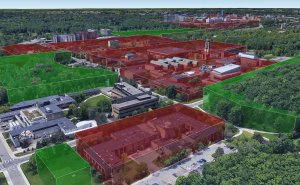Presented By: Michigan Robotics
Robotics PhD Defense: Mia Stevens
Geofencing for Small Unmanned Aircraft Systems in Complex Low Altitude Airspace

As small unmanned aircraft systems (UAS) are utilized in an increasingly wide variety of commercial and civil applications, safety of flight within low altitude airspace can be improved through use of electronic geofence systems to partition the airspace. A geofence is defined as a volume of airspace with specific temporal, spatial, and permission constraints. This thesis develops geofencing as a tool for individual UAS and for managing airspace utilization through UAS Traffic Management (UTM). Permissions constraints determine which UAS may fly within each geofence. As a safety system, geofencing aims to keep the UAS within the airspace sectors (keep-in geofences) it has permission to access. Similarly, geofencing prevents the UAS from entering the airspace sectors it does not have permission to access (keep-out geofences). This thesis offers three specific contributions to geofencing.
First, a methodology is developed to enable the UTM system to build and manage the set of active geofences, ensuring a maximum of one geofence per volume of airspace at any given time. Spatial priority of geofences within the UTM system is awarded in order of request, with always active (static) geofences having top priority. Unlike static geofences, dynamic geofences appear and disappear at user-specified times and are spatially and temporally deconflicted to maximize authorized airspace volume. Polygon set operations are used to deconflict the horizontal boundaries of newly requested geofence sets from the existing UTM approved geofence set.
Second, a Triangle Weight Characterization with Adjacency (TWCA) algorithm is developed to efficiently determine whether a UAS is within a given geofence independent of the complexity of its boundary. This algorithm enables the UAS geofence module to quickly check whether the UAS is violating a geofence boundary by decomposing the horizontal boundary into triangles and tracking the occupied triangle over time through an adjacency graph. To test the performance of TWCA against the industry standard of Ray Casting, the run-time per query is calculated for randomly generated geofences and flight paths. The run-time of Ray Casting scales linearly with the number of geofence vertices while the average run-time of TWCA is constant independent of number of vertices. This time independence from geofence complexity is managed by a pre-processing step that enables real-time operation of this algorithm.
Third, to enable the UAS operator or geofence automation to intervene prior to a boundary violation, the geofence polygons are scaled to provide warning and override cues. This boundary layering algorithm utilizes a uniform and a directional buffer distance to scale keep-in geofences inward and keep-out geofences outward. The layering algorithm is designed to handle arbitrary concave polygons, with special cases identified and analyzed through Monte Carlo simulation. Multiple layering techniques are utilized in parallel to increase the likelihood of finding a scaled boundary solution. The statistical results show that the likelihood of success for inward and outward scaling decreases as buffer magnitude increases.
The contributions of this thesis are combined to form a full system simulation, from the request of a new geofence and access to an existing geofence through the prevention of the boundary violation by the UAS.
First, a methodology is developed to enable the UTM system to build and manage the set of active geofences, ensuring a maximum of one geofence per volume of airspace at any given time. Spatial priority of geofences within the UTM system is awarded in order of request, with always active (static) geofences having top priority. Unlike static geofences, dynamic geofences appear and disappear at user-specified times and are spatially and temporally deconflicted to maximize authorized airspace volume. Polygon set operations are used to deconflict the horizontal boundaries of newly requested geofence sets from the existing UTM approved geofence set.
Second, a Triangle Weight Characterization with Adjacency (TWCA) algorithm is developed to efficiently determine whether a UAS is within a given geofence independent of the complexity of its boundary. This algorithm enables the UAS geofence module to quickly check whether the UAS is violating a geofence boundary by decomposing the horizontal boundary into triangles and tracking the occupied triangle over time through an adjacency graph. To test the performance of TWCA against the industry standard of Ray Casting, the run-time per query is calculated for randomly generated geofences and flight paths. The run-time of Ray Casting scales linearly with the number of geofence vertices while the average run-time of TWCA is constant independent of number of vertices. This time independence from geofence complexity is managed by a pre-processing step that enables real-time operation of this algorithm.
Third, to enable the UAS operator or geofence automation to intervene prior to a boundary violation, the geofence polygons are scaled to provide warning and override cues. This boundary layering algorithm utilizes a uniform and a directional buffer distance to scale keep-in geofences inward and keep-out geofences outward. The layering algorithm is designed to handle arbitrary concave polygons, with special cases identified and analyzed through Monte Carlo simulation. Multiple layering techniques are utilized in parallel to increase the likelihood of finding a scaled boundary solution. The statistical results show that the likelihood of success for inward and outward scaling decreases as buffer magnitude increases.
The contributions of this thesis are combined to form a full system simulation, from the request of a new geofence and access to an existing geofence through the prevention of the boundary violation by the UAS.